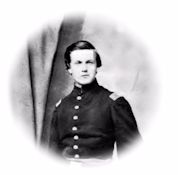Yellow Bluff, Fla.,
Saturday, June 18, 1864.
Dear Sister L.:—
Last week I sent you something pretty. I made myself happy imagining your expressions of wonder when you get the pen box, and of delight when you see the exquisite beauty of the little shells it contains. I captured them at the house of a rebel colonel, which we burnt down. He was the gentleman who fitted out the nest of torpedoes, one of which blew up the Harriet Weed. Did I tell you about my finding the box of powder (one hundred and fifty pounds of cannon powder) in his family graveyard? It was a little brick enclosure deep in the woods near Cedar Creek. In the corner was a box nailed up. On the box was a heavy set of dinner plates and a pitcher. Inside the box was another one covered with leather, and inside that in pound bags of red flannel was the powder. Of course, I destroyed it. Near the graveyard, hid in the bushes, I found two barrels of sugar and one of molasses, which I threw into the creek.
It was on this march that I took my first rebel prisoner. We had surrounded a house just before daylight, and while the others were searching the house, I concluded to peep into an out-building, and who should I see but Mr. Johnny just getting into his “don’t-speak-of-’ems.” He “allowed it was all up with him,” and I allowed ditto. He was a pretty fine fellow, belonging to the Second Florida Cavalry.
I suppose Almon-d (what about that “d”?) is somewhere about Gaines’ Mill now. They had another terrible fight there, and I see a long list of wounded in the One hundred and twelfth. I did not see his name. Colonel Drake was among the killed, and Hubbard, Cushing and Tillotson wounded. I think Grant is bound to win this time.
I received a letter from E. at the same time I got yours. He was on detail then in Toledo after deserters. His regiment was at Johnson’s Island guarding rebel prisoners and he expected to return the next day. Chauncey Ayres is chief bugler of the Ninth New York Cavalry.
Oh, but I do wish you could see the flowers I have on my table this morning! Beside a grand magnolia I have a Spanish bayonet, a cone-shaped or egg-shaped flower two feet high and a foot in diameter. It is shaped like this:
(sketch omitted.)
One solid head like that emitting an exquisite perfume. If you could slice one down the middle, the transverse section would look like this:
(sketch omitted.)
From the main spike stems radiate in every direction with a bell-shaped flower at the end of each stem, and they are so close together as to present the appearance of a beautiful white cone, with proportions that in a flower are magnificent. By putting oleanders, jessamines and roses in among the stems you can have a beautiful bouquet of gigantic dimensions.



